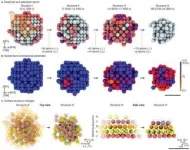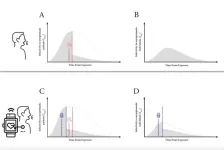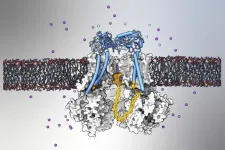Mount Sinai researchers identify molecular glues that protect insulin-producing cells from damage related to diabetes
2025-03-04
(Press-News.org)
Researchers from the Icahn School of Medicine at Mount Sinai in New York have discovered a novel approach to protecting insulin-producing beta cells from the damaging effects of glucolipotoxicity—a harmful condition linked to the progression of type 2 diabetes (T2D). These findings, published on March 2, 2025 in Nature Communications, could lead to promising treatments targeting beta cell dysfunction.
For patients, this research could lead to new treatments that protect the insulin-producing cells in the pancreas, potentially slowing or even preventing the progression of diabetes, thus reducing the need for insulin therapy and improving long-term blood sugar control. Unlike current therapies that primarily manage blood sugar levels, this approach would allow doctors to directly target beta cell loss, which could improve long-term disease outcomes for their patients.
“This is an exciting step forward in our understanding of beta cell protection and the prevention of diabetes deterioration,” said lead author Liora S. Katz, PhD-Associate Professor of Medicine (Endocrinology, Diabetes and Bone Disease) at the Icahn School of Medicine. “For the first time, we’ve shown that it’s possible to use small molecules to fine-tune carbohydrate response element binding protein (ChREBP) activity in a way that could have major therapeutic implications.”
More than 500 million people worldwide are living with diabetes, a disease characterized by high blood sugar levels due to insulin resistance and/or beta cell failure. In T2D, long-term exposure to high glucose and fatty acid levels (glucolipotoxicity) can ultimately lead to beta cell dysfunction and death.
ChREBP is a transcription factor that plays a crucial role in regulating glucose metabolism. It exists in two main isoforms: ChREBPα and ChREBPβ. This is the first study to identify and develop small molecules—termed "molecular glues"—that enhance the interaction between ChREBPα and 14-3-3 proteins in pancreatic beta cells.
The molecular glues in this case increase the binding between 14-3-3 proteins and ChREBPα, which is anchored in the cytoplasm of the beta cell by the 14-3-3 proteins. Under conditions of glucolipotoxicity, ChREBPα goes into the nucleus and starts making too much of ChREBPβ, which acts to disable and even kill the patient’s beta cells. By using a molecular glue designed to increase the binding of ChREBPα to 14-3-3 proteins, ChREBPα never leaves the cytoplasm, cannot enter the nucleus, and therefore does not make ChREBPβ.
When tested in primary human beta cells, these molecular glues significantly reduced the toxic effects of glucolipotoxicity, thus preserving beta cell function and identity. This discovery represents a major shift in diabetes research, as transcription factors like ChREBP have long been considered "undruggable" targets. The study also highlights the broader potential of molecular glues for modulating similar interactions in other diseases.
“Our findings suggest a completely new strategy for preserving beta cell function in diabetes,” said Donald K. Scott, PhD, Professor of Medicine (Endocrinology, Diabetes and Bone Disease) at the Icahn School of Medicine. “This approach could complement existing diabetes treatments and help prevent disease progression.”
Researchers are now working to refine these compounds and evaluate their potential for clinical translation. Future studies will focus on optimizing the molecular glues for therapeutic use and testing them in preclinical diabetes models.
This study was done in collaboration with research teams from Eindhoven University of Technology in the Netherlands and the University of Duisburg-Essen in Germany. The work was supported in the United States by NIH/NIDDK R01DK130300 and the Human Islet and Adenoviral Core (HIAC) of P30DK020541, and in the European Union through ERC Advanced Grant PPI-Glue (101098234), the Netherlands Ministry of Education, Culture and Science (Gravity program 024.001.035), the Netherlands Organization for Scientific Research (ECHO grant 711.018.003), and by DFG-funded CRC1093 (Supramolecular Chemistry on Proteins).
Click HERE for a link to the full study.
About the Mount Sinai Health System
Mount Sinai Health System is one of the largest academic medical systems in the New York metro area, with 48,000 employees working across eight hospitals, more than 400 outpatient practices, more than 600 research and clinical labs, a school of nursing, and a leading school of medicine and graduate education. Mount Sinai advances health for all people, everywhere, by taking on the most complex health care challenges of our time—discovering and applying new scientific learning and knowledge; developing safer, more effective treatments; educating the next generation of medical leaders and innovators; and supporting local communities by delivering high-quality care to all who need it.
Through the integration of its hospitals, labs, and schools, Mount Sinai offers comprehensive health care solutions from birth through geriatrics, leveraging innovative approaches such as artificial intelligence and informatics while keeping patients’ medical and emotional needs at the center of all treatment. The Health System includes approximately 9,000 primary and specialty care physicians and 11 free-standing joint-venture centers throughout the five boroughs of New York City, Westchester, Long Island, and Florida. Hospitals within the System are consistently ranked by Newsweek’s® “The World’s Best Smart Hospitals, Best in State Hospitals, World Best Hospitals and Best Specialty Hospitals” and by U.S. News & World Report's® “Best Hospitals” and “Best Children’s Hospitals.” The Mount Sinai Hospital is on the U.S. News & World Report® “Best Hospitals” Honor Roll for 2024-2025.
For more information, visit https://www.mountsinai.org or find Mount Sinai on Facebook, Twitter and YouTube.
END
ELSE PRESS RELEASES FROM THIS DATE:
2025-03-04
Everyday smartwatches are extremely accurate in detecting viral infection long before symptoms appear — now, research shows how they could help stop a pandemic before it even begins.
Early detection of sickness is critical for preventing its spread — whether it’s COVID-19, influenza or the common cold. Yet, many illnesses are at their most contagious before people even know they’re sick. Research shows that 44 percent of COVID-19 infections were spread several days before the sufferer came down with symptoms.
Now, researchers at Aalto University, Stanford University and Texas A&M, have released a study that models how smartwatches ...
2025-03-04
Both the UN and several Nobel laureates have said that political and economic inequality is a driver of high carbon emissions.
The argument is that more democratic societies – where wealth, power and opportunities are more evenly distributed – are better at reducing their emissions.
But that is not true – quite the opposite.
“Some people hold that a rich power elite stands in the way of climate action, and that democracies can more easily implement measures such as banning emissions or raising taxes,” said Professor Indra de Soysa from the Norwegian ...
2025-03-04
EMBARGOED FOR RELEASE
Tuesday, March 4, 2025 at 9:00 am Eastern Time
An advanced copy of the full recommendation is available upon request.
Media Contacts
American College of Gastroenterology
Becky Abel mediaonly@gi.org (301) 263-9000
American Gastroenterological Association
Annie Mehl communications@gastro.org (301) 272-0013
American Society for Gastrointestinal Endoscopy
Andrea Lee alee@asge.org (630) 570-5601
North Bethesda, MD; Bethesda, MD; and Downers Grove, IL (March 4, 2025) ...
2025-03-04
E. (Sarah) Du, Ph.D., an associate professor in College of Engineering and Computer Science at Florida Atlantic University, has been selected as a Senior Member of the National Academy of Inventors (NAI) for her significant contributions to innovation and invention.
The NAI is a member organization comprising United States and international universities, government agencies, and nonprofit research institutes. The NAI was founded to recognize and encourage inventors with U.S. patents, enhance the visibility of academic ...
2025-03-04
A new study has unveiled a precise picture of how an ion channel found in most mammalian cells regulates its own function with a “ball-and-chain” channel-plugging mechanism, according to investigators at Weill Cornell Medicine. The findings boost the understanding of ion channel biology and could lead to new drugs that target these channels to treat disorders such as epilepsy and hypertension.
Ion channels are protein structures embedded in cell membranes that allow charged molecules to flow into or out of the cell. They support essential biological functions, including signaling or communication between brain cells. The study, published ...
2025-03-04
March 4, 2025
Contact: Morgan Sherburne, 734-647-1844, morganls@umich.edu
Images of pollinators and plants
ANN ARBOR—An herbicide may "drift" from the agricultural fields where it's sprayed and harm weeds that grow at the edge of the fields, impacting pollinators.
A University of Michigan study examined the effects of the herbicide, called dicamba, and found that plants exposed to dicamba drift had a lowered abundance of pollinators, and that pollinator visits to flowers were reduced for some weeds, but not others. The study, led by U-M professor of ecology and evolutionary biology Regina Baucom, ...
2025-03-04
Racial segregation remains common in US schools, 70 years after federal legislation formally outlawing segregation by race. But previous research has demonstrated that integration can benefit students of all races and ethnicities. Students at integrated schools learn how to make connections with children from different backgrounds, developing empathy and mutual respect. Madison Landry and Nabeel Gillani explored whether merging schools could help integrate schools. One school could offer kindergarten through second grade for the current catchment areas of two elementary schools, while the remaining school could serve third through fifth graders for the ...
2025-03-04
Your smartwatch can probably tell that you are sick before you can—and if everyone followed their watch’s advice to self-isolate, incipient epidemics could be stopped in their tracks, according to a study.
During the early days of COVID-19, research showed that 44% of infections were spread before people even felt sick, making early detection critical for stopping outbreaks. Recent studies have demonstrated that smartwatches can detect infections before symptoms appear by picking up subtle physiological changes, ...
2025-03-04
Ideal locations and scales for offshore wind installations depend on both physical conditions and social acceptability. Rudolph Santarromana and colleagues conducted a spatial multi-criteria analysis considering both techno-economics and a socio-environmental impacts, including a broad range of possible concerns, including visual, fishing, marine life, and vessel traffic impacts. Fifty-eight percent of plant location alternatives are suitable from the perspective of developers (techno-economic perspective), but just eighteen percent of sites are suitable from the perspective of a broad range of external stakeholders (socio-environmental perspective). ...
2025-03-04
Hydrogen energy is emerging as a key driver of a clean, sustainable future, offering a zero-emission alternative to fossil fuels. Although it is promising, the large-scale production of hydrogen relies heavily on expensive platinum-based catalysts, and hence affordability remains a major challenge for the industry.
To surpass this, researchers from the Tokyo University of Science (TUS) have developed a novel hydrogen evolution catalyst, bis(diimino)palladium coordination nanosheets (PdDI), that offers platinum-like efficiency at a fraction of the cost. Their groundbreaking study, which was published on November ...
LAST 30 PRESS RELEASES:
[Press-News.org] Mount Sinai researchers identify molecular glues that protect insulin-producing cells from damage related to diabetes












